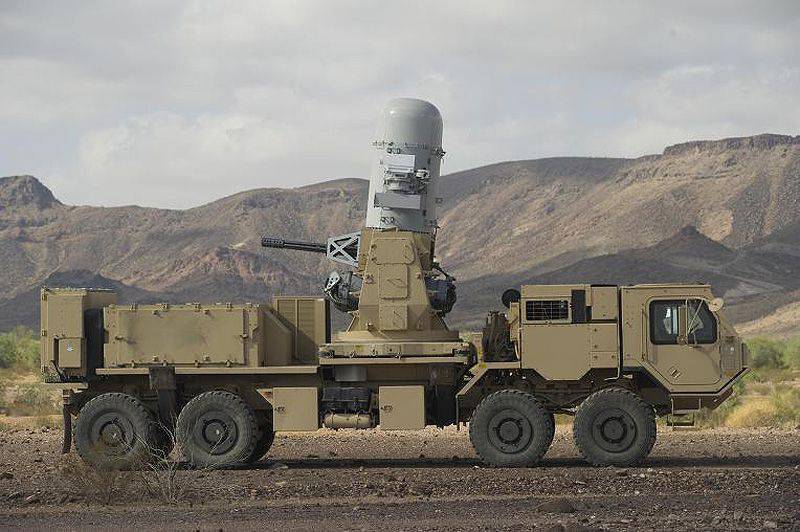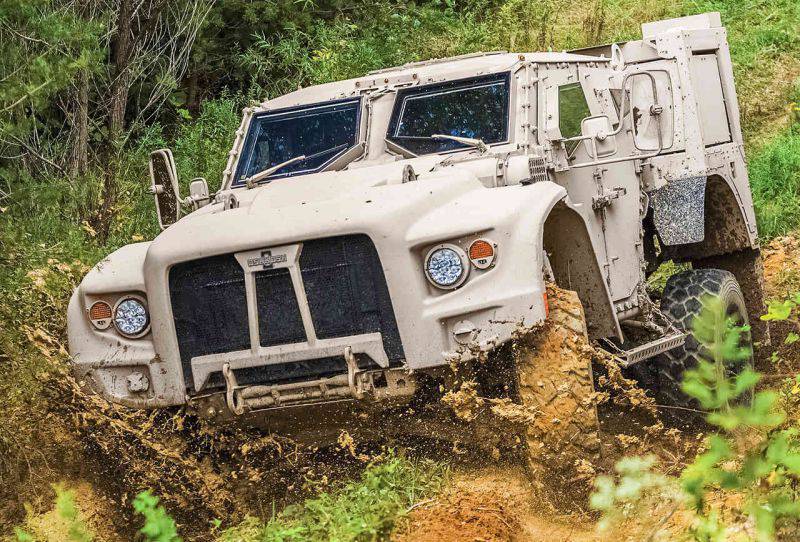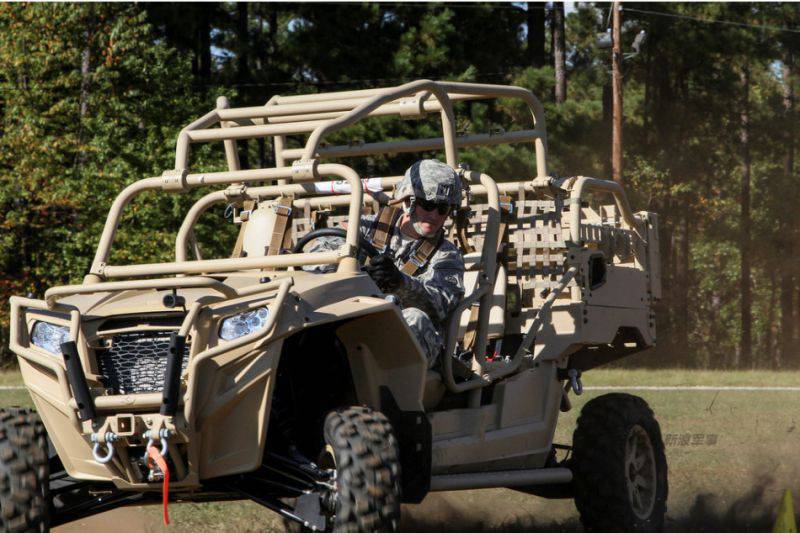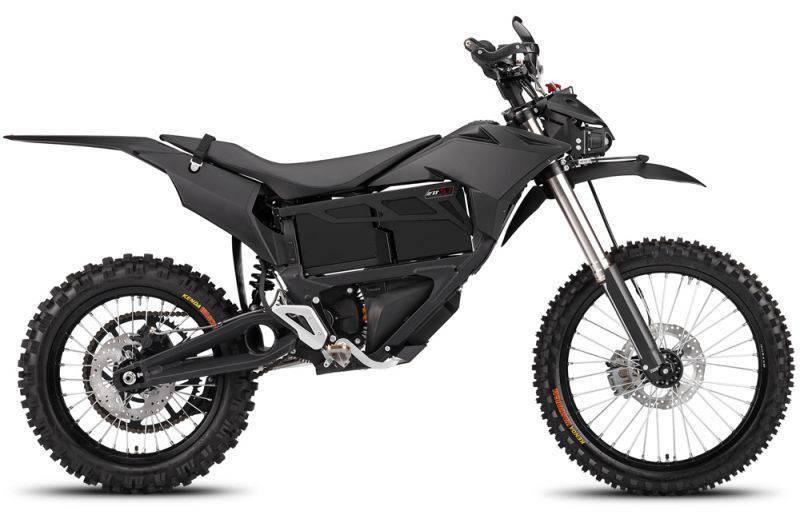Power balance. Hybrid drives for combat vehicles
Oshkosh L-ATV, proposed for the US Army JLTV program, has the option of a hybrid diesel-electric powertrain
The technology of hybrid and electric drives, as a rule, is associated with the world of commercial vehicles rather than with military platforms. However, things can change.
The market for armored vehicles enjoys the benefits of technological progress, but remains wary about the effects of innovation. Progress is a process of step-by-step development, the purpose of which is to demonstrate to customers clear operational advantages, since the ultimate success of a combat vehicle is measured by completed tasks and saved lives.
The mechanical reliability of a diesel engine, automatic speed transmission, drive shaft and differential has long been proven, the same can be said about the technology of hybrid and electric drive. But, despite assessment programs, demonstration machines, companies wishing to invest in research and development, and quite successful development of hybrid diesel / electric drives in the civilian sector, the use of electric drive technology in the military sphere is very conditional today.
Direct approach
Probably, it would be possible to take a risk and rely on the technology of direct drive in combat operations with human participation, but it turned out to be rather difficult to make such a step. Consumers want improved ballistic protection with a V-shaped hull, the fire power of a remotely controlled weapon module and an improved information management system. They also need proven characteristics of the power drive in order to carry all these systems at the proper speed, while providing sufficient moment and power to overcome the slopes and force the rivers.
Counting on electric drives means replacing mechanics with an architecture that differs fundamentally. In the case of an all-electric drive, this means using batteries to drive electric motors that directly rotate the wheels. Such an all-electric circuit has successfully established itself in unmanned systems, for example, in the Northrop Grumman company’s Cutlass ammunition clearance device, developed in 2013 year and currently in service with the British armed forces. This six-wheeled machine due to electric motors in the hubs is capable of speeding up to 11 km / h.
Michael Soymar, Technical Director of L-3 Combat Propulsion Systems, explained that this type of electric drive is packed with brakes inside the wheels. The result was a circuit that he called the "true direct drive."
Regarding its advantages, he noted: “An additional downshift is included in the drive wheel in order to optimize speed and torque. Each wheel can drive a car independently, offering significant redundancy and increased safety. ”
According to Soimar, other direct actuators have electric motors on axles, but they do not have such advantages as engines in hubs.

Diesel-electric car HEMTT A3 on the Hume landfill with Phalanx anti-aircraft installation
In the shadow
The absence of bridges frees up space in the housing and allows you to significantly change the layout of the machine. These advantages of the direct drive design were evaluated in 2004 by the Marine Corps and the command of special operations forces on a deep reconnaissance and target designation machine, named Shadow.
The Shadow machine was manufactured by General Dynamics with the participation of the German manufacturer Magnet-Motor (currently a division of L-3 Communications), which supplied hub engines. The machine uses its air suspension in order to change the overall height; the wheels retract into the body on the 43 cm and the ground clearance is reduced to 10 cm. This means that the Shadow machine, having the same internal volume as the HMMWV, can freely enter the tilt-glider V-22 Osprey for airborne transport.
The drawback of electric traction is that the duration of work depends on the capacity of the batteries and the availability of an external power source for recharging. The maximum duration of Cutlass, for example, is only three hours.
Fighting these restrictions has led to the development of a hybrid electric drive (HPP), which uses an internal combustion engine to drive a generator that charges the batteries in turn. This allowed us to expand the field of practical use of machines with direct drive and such companies as, for example, Iveco, have invested substantial funds in this technology, although for the most part for use in their commercial portfolio.
Commercial progress
Iveco company offers its hybrid systems ECODaily and Eurocargo, which are distinguished by the presence of an electric drive and as a result do not have a gear. The internal combustion engine only works to drive a generator that supplies batteries, and the drive wheels are controlled through electronic systems.
This means that in order to instantly accelerate the batteries at the right time can give a greater amount of energy. Also, this scheme allows regenerative braking, since braking is performed by controlling the electric motors. Reversible rotation to stop the machine turns them into dynamos, generating additional power for recharging batteries and a greater amount of electricity for use in subsystems.
Along with Iveco, which does not seek to transfer its military vehicles to a hybrid drive, the Israeli firm IAI also shares a similar business strategy. In February, 2015 announced the increase in sales of its lightweight armored car RAM Mk3 4x4 and the commissioning of its new hybrid electric tractor TaxiBot hp 800, developed jointly with Lufthansa.
Despite the success of the RAM machines, of which more than 450 units have been sold to date, and the commissioning of the heavy TaxiBot tractor for the German air carrier, IAI does not see the potential in the widespread use of electric drives. The company confirmed that "IAI does not consider the use of hybrid technologies for RAM Mk3".
Soimar explained that interest in electric drive technology is growing among manufacturers of military machines, but the driving force here is, of course, motor-building.
“Hybrid-electric drive technology has reached maturity around the world. The automotive industry is in search of fuel efficiency and lower emissions, and this stimulates technology development. ”
He said that regenerative braking, for example, is widely represented in the civilian commercial sector in cars such as the Toyota Prius and the all-electric Tesla Roadster, but in the field of military vehicles it came to real incarnation only on a heavy-duty off-road truck HEMTT A3 (Heavy Expanded Mobility Tactical Truck), manufactured by Oshkosh, in which it (regenerative braking) is an integral part of the diesel-electric hybrid system ProPulse.
Hybrid drive will show itself
Despite the fact that society is not so quickly ready to evaluate this technology, the adoption of electric drives in the future will become more defined as the civilian sector achieves technical advantages in this area. “The significant progress made over the past few years in software and electronic control of a commercial hybrid electric drive will be appreciated by society and can be made available for military vehicles,” said Soymar.
Developments in breakthrough technology are not limited to control systems. Technologies in the field of batteries are also being improved, where lead-acid types are being replaced by lighter lithium-ion systems with a higher voltage.
Saft not only manufactures lithium-ion batteries for industrial and civil electronics, but is also becoming increasingly popular in the defense market. In 2011, the company delivered its lithium-ion ESS batteries to BAE Systems as part of a technology demonstration contract, the goal of which is to develop a hybrid drive for a promising tracked combat vehicle GCV (Ground Combat Vehicle) of the US Army.
In collaboration with Northrop Grumman, BAE took over the project and built a running test set to evaluate embedded systems, including a power drive, generators, controllers, and software. The mileage of the setup was 3200 km.
The details provided by BAE in the year 2012 related to the improved performance of its hybrid electric drive capable of producing an 1500 hp. and generate electrical power 1100 kW, while fuel economy in this case amounted to 20%.
These tests disproved the assumption that the hybrid drive is not powerful enough for tactical vehicles. The car accelerated from 0 to 32 km / h in 7-8 seconds, and the company stated that its experimental drive was completely silent in operation, not bad for a machine with a mass of 70 tons.
In the car Ultra Light Vehicle with a hybrid drive implemented a number of new technologies
Power problems?
It is a misconception that the gap will have more problems with driving the tracks, not the wheels. BAE Systems’s director of deep and amphibious programs, Deepak Bazaz, said: “There are no particular problems when using a hybrid electric drive on tracked vehicles. This scheme on them is actually easier to implement, since the drive wheel of the tracked vehicles is in one place, this is not just a few axes for the wheel systems. ”
The goal of the GCV program was to replace the Bradley BMP fleet of the American army with hybrid-drive vehicles, but with an estimated 29 cost of billions of dollars and 595 millions of dollars allocated only for technological development, Congress decided that the entire project was too expensive. In 2014, he cut the development budget by 400 million dollars, lowering the status of the GCV program to the technology demonstrator.
The development of the prototype was transferred from the manufacturers to the Army Research Armored Center. A prototype hybrid vehicle is expected to be produced in 2019-2020 years.
Despite this decision, Bazaz said that the company maintains faith in the GEO and remarked: "We are continuing limited testing to demonstrate the reliability of the system."
The fate of GCV exposed the problems of electric drives associated with their adoption in operation. Customers will search, but will not be obliged to order, manufacturers will not take risks for the full development of technology without customer support and firm orders; and both sides expect industry to fully develop the market and gain public acceptance of the technology.
Wait and see
The UK approach is typical. Despite the tight budget and downsizing, the Ministry of Defense didn’t pay attention to the obvious fact that fuel costs money and signed a contract for the so-called unified fuel system in 2012, which will cost up to 1 a billion pounds per year.
The adoption of electric powered vehicles is not currently being considered, despite the potential cost savings. Instead, a wait and see approach was adopted.
In the laboratory of defense science and technology, they explained: “The laboratory is conducting a study of the GEO, which combines previous work on the GEO technologies and their suitability for military conditions. In order to increase the level of understanding of such technologies, previous works on the GEO are used in the study; it includes past and current research by the Ministry of Defense, the defense industry and the commercial automotive industry. ”
The practical result of this process was that the electric drive was not considered as an option for the new program of the British army on an armored vehicle Scout SV.
However, the UK is not alone avoids the electric drive. Australia, France and Poland, all of them are currently in the process of large-scale procurement, which will allow them to replace their fleets of tactical armored vehicles, but none of the new machines (under consideration or under development) will have this technology.
Main obstacles
The size and cost of such programs are major obstacles. The cost of only the first batch of the total in the 2000 Scorpion machines of the French army, the delivery of which is scheduled for 2018 year, is estimated at more than 930 million dollars. Considering such prices and volumes of purchases (Scorpion will replace the entire fleet of French VAB armored personnel carriers), the time for the wide adoption of new drive technologies is simply not the best, especially when reality and practice dictate the creation of a completely new supply chain to support it.
Although hybrid and electric drives are not yet considered mature enough to be implemented, in the future, changing the type of drive may well justify itself. As an example, take the Foxhound protected army patrol car. This armored car, entered service in 2010 year, was developed by Ricardo, which also works in the field of hybridization and electrification. The Foxhound currently has a Steyr turbodiesel engine, but its V-shaped hull was designed by Ricardo with a view to a possible future GEP installation.
In a study conducted in 2009 about developing a new car (then called Ocelot), Ricardo raised the issue of powertrain, arguing that the military would most likely be interested in future hybrid drives because of the need to generate more electricity and improved energy supply of more complex equipment.
From this point of view, Soimar agrees and describes some possible uses of the GEO. “The significant amount of energy they generate allows for special combat and tactical characteristics, for example: silent observation [the engines are turned off, but the sensors are powered by batteries] and maneuvering; improved acceleration for fast escape from hazardous areas; and the ability to supply many new sensors and subsystems, such as active protection systems, directional energy, and countering improvised explosive devices. ”
Zero Motorcycles electric motorcycles were tested by US special forces forces.
Future investment
Increasingly, vehicle upgrades are being considered in terms of electrical power. Agreeing with Soimar’s point of view, Bazaz explained that BAE Systems regards GCV as a possible object for its investment.
“We use our test facility to study the significant potential of the gap, which power will allow, perhaps, to demonstrate a laser system of directed energy,” he said.
As if to confirm these words, in March 2015, Lockheed Martin demonstrated even greater eagerness by successfully field-testing its Advanced Test High Energy Asset advanced advanced high-energy installation, which burned a car's ground-based fiber-optic laser with an 30 kW power from a distance 1,6 km.
The development of these new subsystems will give impetus to the introduction of hybrid drives in the future, since the additional electrical power they produce will become an absolute necessity.
Energy-saving initiatives are also a high priority for the US military, forced to save money on fossil fuels. However, as stated by Oshkosh Defense, reducing this dependence will affect the final balance of power.
“The Ministry of Defense is one of the largest consumers of fuel in the world,” the statement said. “In 2010, the army and the marine corps estimated that the full cost of fuel in Iraq and Afghanistan varied from 9 to 40 dollars per gallon, depending on the delivery routes and fuel replenishment methods.”
"As emphasized in the energy strategy of the Ministry of Defense, the military seeks to better use its energy sources in order to reduce risks for the fighters, to direct available resources to perform tasks with higher priority and to reduce costs."
Here lies the reason why the closure of the GVC program did not diminish the enthusiasm of the Ministry of Defense for the application of electric drive technology. The current program for the light tactical vehicle JLTV (Joint Light Tactical Vehicle) is aimed at replacing the HMMWV armored car with a GEP technology vehicle.
Previous experience
Oshkosh is one of the participants of the JLTV program and, as the company explained, the full-scale experience in diesel-electric systems will be used in the prototype L-ATV (Light Combat Tactical All-Terrain Vehicle).
“The optional hybrid diesel electric drive Oshkosh ProPulse was designed, installed and tested on our L-ATV,” the company said.
Based on the increased competitive pressure associated with the JLTV program, Oshkosh refused to say whether L-ATV would have a gap, but confirmed that an electric power installation “providing power to the on-board systems and external consumers” was installed in the test JLTV vehicle.
Energy for external consumption, generated by a whole fleet of vehicles, increases the prospects for tactical power grids (energy micro networks), which are mobile to the same extent as the ground forces they support. They reduce the dependence on liquid fuels and recharge batteries, on which so much now depends.
The American Army’s electronics and communications center has already started the Tactical Power Generation program to explore this idea, and during a technology demonstration of the energy concepts of the expeditionary forces in June, ready-made solutions were shown to meet future needs for a hybrid vehicle and batteries. .
Related technologies
Unfortunately, the pace of implementation of electric drive technology is still associated with the speed of development of a tactical machine, there is a strong relationship. JLTV production, for example, will start no earlier than 2018, with a production cycle of up to 2030's. In the short term, ground-based unmanned vehicles and ultralight vehicles are a stronger contender for the deployment of electric drive and energy exports.
For example, freight carriersRobots Carry-all Modular Equipment Landrover from Northrop Grumman and Multi-purpose Unmanned Tactical Transport from General Dynamics Land Systems (GDLS), tested by the Marine Corps in 2014, are designed to escort and support a dismounted squad.
Diesel-electric power plants of both robotic machines are capable of generating not only enough energy for their own running motors, but also export 1-2 kW of what in GDLS is called “forwarding energy”.
Meanwhile, there is a growing interest in ultralight two- and three-seater vehicles, and a market for tactical vehicles opens up for manufacturers of hybrid / electric engines such as Millenworks and TomCar. Both companies use their production facilities to meet the need for patrol cars transported by air, whose main features are speed and maneuverability, as well as hybrid / electric drives, which provide advantages in terms of silent traffic plus reduced signs of visibility in heat and exhaust.
The enthusiasm for light and fast cars also helped increase the interest of the Ministry of Defense in electric and hybrid motorcycles. In 2014, the command of special operations forces tested the MMX all-electric motorcycle manufactured by Zero Motorcycles.
The company Zero do not go into the details of the tests, but they say that they are still ongoing, as well as that interest was shown in the line of motorcycles for the police and security forces by the military police units. The company also confirmed that it works with some foreign armies.
DARPA Interest
In January, 2015, DARPA (Advanced Defense Research Agency) provided Logos Technologies with a grant to research the possibility of developing a military version of the SilentHawk hybrid off-road motorcycle.
Erik Bell’s SilentHawk program manager explained: “Since systems such as cars or ATVs are difficult to deliver in large quantities by air to enemy territory, a silent, off-road motorcycle with a long operation time could be a solution in some cases and, moreover, enter on an equal footing with other vehicles in the evolving concept of hostilities. "
"Off-road motorcycles provide mobility on extreme terrain, such as forest without trails, narrow mountain trails and rocky landscapes, allowing the military to overcome all this and reach the enemy in almost any conditions."
“The advantages of the SilentHawk hybrid drive,” Bell continued, “are the separation of fuel-related components — the engine, fuel tanks, and the cooling system — from the main electrical parts.”
“The entire hybrid system, with the exception of the battery, is removed from the motorcycle, leaving only an electric motorcycle, fully functional, with high performance, having an integrated electric drive with liquid cooling,” he added. “We appreciate the military use of these capabilities at close range, where a motorcyclist can exchange the weight of a hybrid system for additional equipment that he may need during a combat mission.”
Energy is also available for external consumers. Bell explained: “We are planning to create such a motorcycle that would allow operators to recharge various devices from their power grid. We are designing SilentHawk with several power connectors that can meet the need for additional 500 W power. ”
Electric drives and the electric power for external consumers open wide prospects in front of highly mobile forces depending on a stable source of energy. The technologies are already in place, but until someone dares to embed them in the concept of military operations and apply them in practice, the revolution in the tactics of ground forces will remain at the “wait and see” stage.
Materials used:
www.shephardmedia.com
www.oshkosh.com
www2.l-3com.com
www.generaldynamics.com
www.baesystems.com
www.zeromotorcycles.com
www.darpa.mil



Information